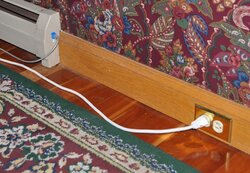I'm in the process of replacing all of the kludged network wiring in my house with Cat6 using wall plates and patch panels. One problem that I have is that I don't want to damage the vapor barrier in the outside walls. Outlets are in 3/4" shallow boxes in the baseboard trim. I came up with this solution to mount a network jack in an outside wall. My son thinks it may be the first gigabit baseboard.....
Hydronics meets Cat6
- Thread starter Nofossil
- Start date
-
Active since 1995, Hearth.com is THE place on the internet for free information and advice about wood stoves, pellet stoves and other energy saving equipment.
We strive to provide opinions, articles, discussions and history related to Hearth Products and in a more general sense, energy issues.
We promote the EFFICIENT, RESPONSIBLE, CLEAN and SAFE use of all fuels, whether renewable or fossil.


